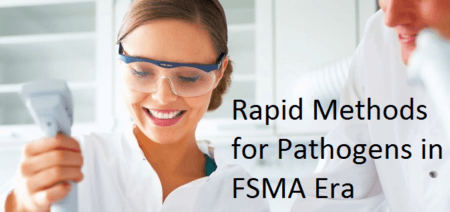Rapid Methods for Pathogen Detection in the FSMA Era
Why Rapid Methods?
Rapid methods of pathogen testing have been gaining acceptance in the food industry. Recent advances in technology result in faster detection and identification of pathogens, more convenient, more sensitive, more reproducible, and more specific than conventional methods. The main reasons for their adaptation are because faster results mean:
- Faster intervention and corrective actions
- Fewer lost lots or reduced amount of product in a contamination event
- Faster reaction to a problem
- Improved throughput and reduced warehouse space
- Decreased manufacturing cycle through faster release of inventory
- Ability to link strains of pathogens to a specific case
- Accelerates root cause analysis
- Rapid pathogen testing can be useful in preventing an outbreak of illness
For ready-to-eat products, the new FSMA proposal requires environmental pathogens to be controlled. As a result, environmental pathogen testing is required in some segments of the industry. In most cases, the cost of assay materials increases with new methods. However, the operational and financial benefits far outweigh the expense.
Available Methods
It is important to remember, in most foods, rapid methods still lack sufficient sensitivity and specificity for direct testing of the food. Therefore, the foods still need to be enriched in a culture media before the rapid method analysis. New methods include antibody-based assays, genetic amplification methods, and newer sensor development methods. TheFood OnLine article discusses in more details:
- Growth-based methods
- Immunological-based methods
- Molecular detection methods
- Biosensor devices
- Whole Genome Sequencing (WGS)
What About FSMA?
FSMA requires food producers, processors, manufacturers, and service providers to certify their products are free from pathogens, such as Listeria, Salmonella, and pathogenic E. coli. The testing results obtained must use valid pathogen testing protocols.
Typically, all methods for pathogen testing are validated by vendors through an organization, such as AOAC International , MicroVal, or AFNOR, either by an independent laboratory or a more stringent multi-laboratory study. However, according to FSMA, all microbiology methods utilized must be proven to be adequate for the particular products tested. Validation is required to demonstrate the method is equivalent to the reference method (for the matrices validated). Method verification will demonstrate it achieves an acceptable level of precision and accuracy, and there are no matrix effects or interference when utilized for the particular product(s) of the company.
Laboratory Accreditation
FSMA mandates laboratory accreditation with the objective to align commercial laboratories with government labs. This would assist the acceptance of analytical data, improve the efficiency of government labs, and support the testing of food imports. The FDA establishes an accredited third-party certification body that must be used in a laboratory accreditation. The accreditation is done to the ISO 17025 standard, or equivalent. These accredited labs will report results of public health concern directly to the FDA. The agency is required to establish a registry of accrediting bodies and accredited laboratories that includes laboratory contact information. Laboratories must be accredited for the particular sampling or analytical testing methodologies used to analyze their particular products. The new rules are placing greater emphasis on laboratory expectations, technical competence, and use of validated methods, and thereby, improved consistency across the industry in producing reliable data. According to Tom Wechler, lab accreditation is not inconsequential. A sizable initial investment is required in order to put systems in place and provide proper training for staff. The review fee for accreditation can run $15,000 or more and, once accredited, labs can expect additional ongoing costs for staffing, management and overall compliance.
Pathogen Testing Market Size
The demand for microbiological testing in the food industry is higher than ever before. Pathogen testing seems to account for over 50 percent of the entire microbiological testing market and its growth rate is three times greater than that of the total market. For more details go to Food OnLine article.
Difficult Choices
 While the new methods offer advantages in technology, speed, and accuracy, they represent an incremental progress, rather than a revolution. It seems like every so often we hear about a new better methodology coming to market.
While the new methods offer advantages in technology, speed, and accuracy, they represent an incremental progress, rather than a revolution. It seems like every so often we hear about a new better methodology coming to market.
With the large number of competitors in the pathogen testing arena, it is hard to differentiate among the technologies and find the clear winners. Every small progress of one technology is soon followed by a competitor that makes it slightly better.
With over 40 different assays on the market it is increasingly more difficult for companies to choose a new rapid method and to decide to invest in it. This might be one of the reasons that laboratories. Small- and mid-sized food plant labs are closing, and looking to contract testing labs for their pathogen testing. The extensive validation requisite as part of FSMA, as well as the increased training and documentation requirement, is driving smaller manufacturers toward contract laboratories. Some of the difficult choices include:
- Internal (In-House Testing Lab) Or External Testing Lab Internal laboratories can yield faster results. With faster results comes faster access to data. However, increasingly sophisticated and price competitive contract laboratories offer a good alternative. Furthermore, food company customers — including global food retail and food service companies — are requesting analytical results provided by an accredited third-party lab rather than the food plant itself.
- Standard Methods Or New Methods? If New, Which New Method Should You Use? Newer and more rapid method are generally more sensitive, specific, time-efficient, labor-saving, and reliable than conventional methods and are currently more frequently used. Most of the U.S. market has moved to newer methods, while close to 50 percent of the European market is using the newer methods. Technology continues to evolve at a faster pace and the next generation assays are being developed.
Currently, numerous technologies are under development, pushing the limits of current methodologies. Some are trying to move current technologies forward, such as digital PCR, next generation sequencing. One essential step is the separation or concentration of the organisms from the sample prior to the utilization of rapid methods.
One technology attracting interest is Magnetic nanoparticles (MNPs) due to its super-paramagnetic property and large surface-to-volume ratio as excellent ligand attachment. There is a need for automation and the removal of manual steps that slow down the assay time. We expect constant progress in new method development over the next couple of years.

